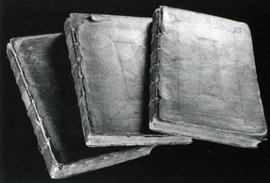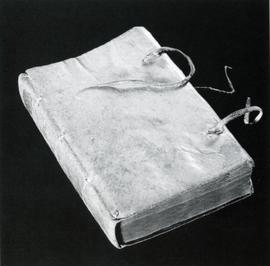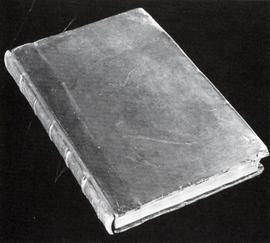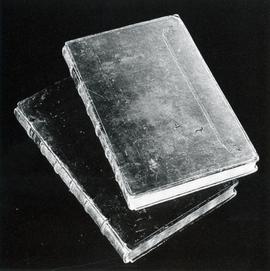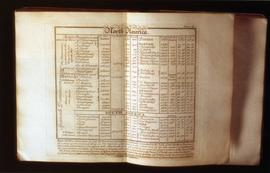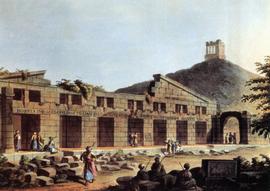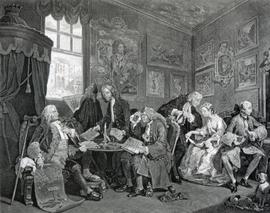
Identity elements
Reference code
Name and location of repository
Level of description
Title
Date(s)
- 1883-1998 (Creation)
Extent
66.44 linear feet (64 boxes)
Name of creator
Biographical history
Vera Way Marghab was the co-founder and president of Emile Marghab Inc., New York, and Marghab, Ltd., Madeira—renowned producers of fine linens. Born on August 21, 1900, in Wesley, Iowa, to Stitzel X. Way and Kathryn Bacon Way, Vera became a visionary in the world of luxury textiles.
In 1934, she and her husband, Emile Marghab, established their business, which specialized in exquisite embroidered linens crafted by skilled artisans in Madeira. Their products were sold exclusively in prestigious shops worldwide. Following Emile’s passing in 1947, Vera managed the company independently until political changes in Madeira forced its closure in 1984. Shortly after, she returned to Watertown, South Dakota, where she expanded her childhood home, "Wayland," on Lake Kampeska and settled into the community.
Emile Marghab, originally Emile Mogabgab, was a British subject from Cyprus. In 1921, he began managing the L. Tweel Importing Co. House, an importer of hand-embroidered textiles in Funchal, Madeira. Later, he joined F. M. Jabara and Bros., another embroidery firm, before co-founding Farra and Mogabgab Ltd. with Gabriel Farra. By 1930, Emile and Farra leased a factory from Jabara and operated independently, securing buyers in England and New York.
After marrying Vera in 1931, Emile changed his surname at her insistence. Vera quickly became involved in the business, bringing fresh ideas for management and production. When Farra sold his stake in 1933, Vera became Emile’s partner, and the couple undertook significant improvements to the company.
Renaming the business Marghab Ltd., Vera and Emile sought to elevate their products' quality. They sourced the finest linen from Irish weavers and collaborated with Swiss weavers to develop Margandie, a fabric made from premium Egyptian cotton.
Vera played a crucial role in design, ensuring that Madeira embroiderers adhered to her exacting standards. Unlike other companies, Marghab Ltd. maintained a permanent collection of designs, a revolutionary concept in the linen industry. This commitment to consistency and quality set the brand apart.
In 1934, Vera and Emile launched a U.S. branch, Emile Marghab Inc., in New York City, focusing on exclusive marketing strategies. Vera devised the Marghab Shops concept—dedicated spaces within select high-end department stores that adhered to strict display and layout guidelines. Each shop was managed by a personally trained expert under Vera’s direction.
Advertising was similarly controlled. Stores could only advertise Marghab products with Vera’s explicit approval, ensuring the brand’s elite status. This meticulous oversight preserved the linens' prestige and sustained business growth.
At its peak, the Marghab business was synonymous with luxury. However, after Emile’s passing in 1947, shifting consumer preferences and Vera’s rigid business practices led to a gradual decline. By the late 1970s, increasing demands from the Madeira embroidery guild (Gremio), coupled with political upheaval in Portugal and Madeira, made it difficult for Vera to continue operations. By 1984, both Marghab Ltd. and Emile Marghab Inc. had ceased operations.
Marghab linens, celebrated for their unparalleled craftsmanship, adorned palaces and embassies worldwide. Today, several designs remain part of the permanent collection at the Metropolitan Museum of Art in New York City. A complete collection—1,918 pieces spanning 282 designs—is preserved at the South Dakota Art Museum in Brookings, South Dakota.
Vera Way Marghab’s legacy endures, a testament to her dedication to quality, innovation, and timeless elegance.
Content and structure elements
Scope and content
The Vera Way Marghab Papers is a comprehensive archive documenting the life and work of a woman who played a significant role in the luxury textile industry. The collection offers insight into her personal journey, from her early years in South Dakota to her time as a piano student in New York City, as well as her relationship with Emile Marghab through extensive correspondence. While much of the material is centered on her personal life, the collection also reflects her role in the linen industry as the driving force behind Marghab, Ltd. and Emile Marghab, Inc. The records highlight her meticulous nature, as she preserved extensive documentation on both her personal and professional endeavors. Given the interwoven nature of her life and career, the materials are arranged into distinct series that provide a structured approach to understanding her legacy.
The Business Series encompasses all aspects of the Marghab enterprises, both in New York and Madeira. It includes materials on the founding of the company, capturing the vision and strategy behind Emile and Vera’s business model, as well as its eventual dissolution. Correspondence reflects their relationships with artisans, business partners, and shop managers, while records on design illustrate Vera’s influence in maintaining the highest standards of quality. Trademark and copyright documents, including coded correspondence aimed at protecting proprietary designs, shed light on the competitive nature of the textile industry. One of the aspects of this series is the material related to the Mayflower cloth, a specially designed tablecloth for the 1957 Mayflower II voyage, which later became an exhibition piece at the World’s Fair in Australia. Administrative records from the New York and Madeira operations provide insight into the governance and structure of the business, including shareholder meetings, factory logistics, and high-profile engagements with diplomats and the U.S. Navy. Employee records detail the hiring process, disputes, and pension plans, while financial records illustrate the company’s fiscal health, including instances of embezzlement and tax matters. The marketing strategy developed by Vera is well-documented, with strict guidelines for Marghab Shops, controlled advertising, and policies that set the company apart from competitors. Records on the shops provide a glimpse into Vera’s selective approach, including her direct correspondence with store managers and evaluations of potential retail locations.
The Personal Series reflects Vera’s multifaceted life beyond her business endeavors. Materials include portraits and fabric samples that visually represent her legacy. Her commitment to philanthropy is evident in records of charitable donations and correspondence with organizations she supported. A large portion of the series consists of clippings and collected materials, which demonstrate her curiosity and engagement with various subjects. Personal correspondence includes letters to and from family, friends, and colleagues, some of which intersect with business matters. Financial records cover her personal wealth management, including investments, estate planning, and legal affairs. The series also includes materials on her life in Madeira, providing additional context to her time spent there beyond the confines of business. The establishment of the Marghab Gallery at the South Dakota Art Museum is well-documented, capturing her dedication to preserving the artistry of Marghab linens. Music played an important role in Vera’s early life, and materials on her musical education and performances offer insight into this passion. Personal writings, including reflections and philosophical musings, provide a more intimate look at her character and outlook on life.
Significant figures in Vera’s life are highlighted through correspondence and clippings, most notably her husband, Emile, and her immediate family. Her engagement with politics is documented through materials on political figures and organizations of interest to her. Rare book records illustrate her scholarly interests and her contributions to South Dakota State University’s library. Recognition for her contributions to the textile industry and beyond is captured in awards, articles, and documentation of a Marghab video project. Social engagements and affiliations with arts organizations further reflect her cultural involvement. Her extensive travels, both domestic and international, are documented in travel records, revealing her connections to a broader global network. Her deep ties to Watertown, South Dakota, are evident in materials related to her home, Wayland, and her properties on Lake Kampeska, as well as documentation on community events and restoration projects.
This collection is of exceptional significance, offering researchers a rich narrative of a woman who was both a cultural tastemaker and a shrewd business leader. It captures the evolution of a company that set new standards in luxury linens, the meticulous approach that defined its success, and the challenges it faced in an ever-changing economic and political landscape. Equally important, it provides a deeply personal portrait of Vera Way Marghab, allowing scholars to explore the intersections of entrepreneurship, artistry, and personal ambition. The collection stands as a valuable resource for those interested in business history, women’s history, textile design, and the legacy of craftsmanship that Marghab linens represent.
System of arrangement
This collection is arranged into series:
- MA 25.1. Business records
- MA 25.2. Personal records
- MA 25.3. Photographs
- MA 25.4 Rare Book Collection
Conditions of access and use elements
Conditions governing access
The collection is open to all researchers, with materials accessible on-site only and not available for circulation.
For extensive research, scheduling an appointment in advance via phone or email is encouraged, including details about the research topic and intended use.
To access materials, researchers must complete and sign the Registration Form and provide proof of identity (e.g., University ID or driver’s license). By signing, researchers agree to adhere to the Reading Room Rules. The registration document also includes guidelines on making copies of materials, correct referencing, and copyright obligations.
Physical access
Technical access
Conditions governing reproduction
South Dakota State University supports access to its collections, both published and unpublished. However, access to certain items may be restricted due to their fragile condition, donor agreements, or copyright.
Reproduction of materials is allowed for research purposes only, and written permission is required for publication or distribution.
Due to the delicate nature of some items, reproduction may be limited.
Languages of the material
- English
Scripts of the material
Language and script notes
Finding aids
Acquisition and appraisal elements
Custodial history
Immediate source of acquisition
Appraisal, destruction and scheduling information
Accruals
Related materials elements
Existence and location of originals
Existence and location of copies
Related archival materials
Perfection, never less: the Vera Way Marghab story by D.J. Cline
Brookings, S.D.: South Dakota Art Museum, 1998.
Call number: SD Collection: TS1725.C54 1998
Marghab rare book collection: Hilton M. Briggs Library by Hass, Nancy J. and Lisa Rae Lindell
Brookings, S.D.: Hilton M. Briggs Library, South Dakota State University, 1996.
Call number: Archives: Z1029.M37 1996
Ideals wrought in linen: the story of Marghab, South Dakota Memorial Art Center. Marghab Gallery
Brookings, S.D.: Marghab Gallery, South Dakota Memorial Art Center, South Dakota State University, [1970].
Call number: SD Collection: NK9201.B7 S6
Related descriptions
Publication notes
The Moghabghab Family in Cyprus, New York, and Madiera, 1878-1974
Article by Nicholas Stanley-Price on Emile Marghab's family.
Notes element
General note
Ask Us!
If you have questions or would like to schedule a visit, please let us know.
General note
Copyright and Use Statement
In Copyright This Item is protected by copyright and/or related rights. You are free to use this Item in any way that is permitted by the copyright and related rights legislation that applies to your use. For other uses, you need to obtain permission from the rights-holder(s).
Materials in this collection may be subject to Title 17, Section 108 of the United States Copyright Act. Users are responsible for ensuring compliance with copyright, privacy, trademark, and other applicable rights for their intended use. Obtaining all necessary permissions is the user's responsibility. Written authorization from the copyright and/or other rights holders is required for publication, distribution, or any use of protected materials beyond what is permitted under fair use.
Specialized notes
Alternative identifier(s)
ID
ID
Description control element
Rules or conventions
Sources used
Access points
Subject access points
Place access points
Name access points
- Emile Marghab, Ltd. (Subject)
- Marghab, Vera Way, 1900-1995 (Subject)
- Marghab, Emile, 1895-1947 (Subject)

